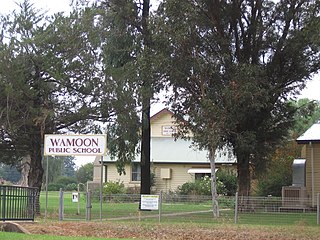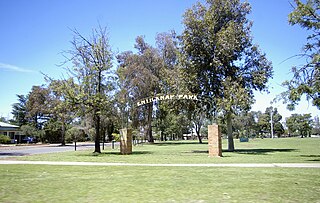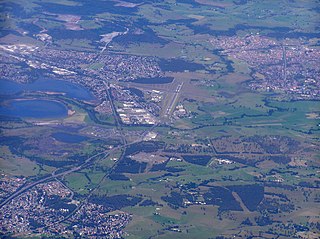
Yanco is a village with a population of 505 in Leeton Shire in south western New South Wales, Australia. Yanco is a Wiradjuri aboriginal language word meaning the sound of running water. Yanco is located 3 kilometres (1.9 mi) from Leeton along Irrigation Way. Yanco is home to the Powerhouse Museum, McCaughey Park, Murrumbidgee Rural Studies Centre and Yanco Agricultural High School.

Leeton Shire is a local government area in the Riverina region of New South Wales, Australia. The Shire is located adjacent to the Murrumbidgee River and falls within the Murrumbidgee Irrigation Area.

Englorie Park is a suburb of Sydney, in the state of New South Wales, Australia. Englorie Park is located 55 kilometres south-west of the Sydney central business district, in the local government area of the City of Campbelltown and is part of the Macarthur region.

Wamoon is a village in Leeton Shire in the Riverina region of New South Wales, Australia. Wamoon is located 8.8 kilometres (5.5 mi) from Leeton along the Irrigation Way to the Leeton CBD and Henry Lawson Drive to the Leeton suburb of Wattle Hill. Wamoon provides a village of homes to the farmers of northern Leeton and there is a small primary school known as Wamoon Public School.

The Murrumbidgee Irrigation Area (MIA) is geographically located within the Riverina area of New South Wales. It was created to control and divert the flow of local river and creek systems for the purpose of food production. The main river systems feeding and fed by the area are the Murrumbidgee and the Tumut. It is one of the most diverse and productive regions in Australia contributing over A$5 billion annually to the Australian economy. The MIA was first established in 1912 after the commissioning of Burrinjuck Dam. Further expansion occurred in the 1970s with the completion of the Snowy Mountains Scheme and construction of Blowering Dam on the Tumut River, which meets the Murrumbidgee near Gundagai.
Wattle Hill is a north-western suburb of Leeton, New South Wales. Wattle Hill was developed in the 1970s and 80's as a joint venture between Leeton Shire Council and the New South Wales Department of Housing. Wattle Hill has a large concentration of housing department homes particularly on Gossamer, Wirilda and Blackwood Streets. The rest of the suburb has private residences, a small shopping precinct and three parks, one of which has a large water tower that supplies water to Wattle Hill and Wamoon. During the development of Wattle Hill, it was proposed that a state primary school was to be built in the suburb with land set aside to the west of the suburb, however, the school was built in the nearby suburb of Parkview. Prior to redevelopment, Wattle Hill was an unofficial low-income housing area for many local families. There were many homes there without floors, constructed from poles, flattened 4-gallon drums and hessian.

Parkview is a residential suburb of Leeton, New South Wales in Leeton Shire. Parkview is located to the south west of town, and can be accessed via the Oak Street Bridge. Parkview is home to Leeton's second state school, Parkview Public School, a small shop and butcher, two churches, and an array of sporting facilities such as tennis and basketball courts. Leeton's showground, racecourse and the MIA Sports Club are located to the east of the suburb across the railway track.
Wiradjuri is a subdivision in the rapidly growing Northern area of Leeton, New South Wales in Leeton Shire. Wiradjuri was developed in the 1980s and 90s to cope with Leeton's housing shortage and population boom. The Leeton High School sporting ovals are located to the east.

Murrami is a village located in the Leeton Shire in New South Wales, Australia. Murrami has a post office, a rice storage facility, and a small community centre and park. The Freedom Foods Factory is located nearby as is Randall's Organic Rice. The place name is derived from an aboriginal word for 'crayfish'.. A local tourist attraction is Rockinghorse Restorations. Murrami Post Office opened on 18 December 1922.

Willimbong is a suburb of Leeton, New South Wales, Australia in Leeton Shire. Willimbong has a mix of industrial and residential properties. Leeton's SunRice and Coprice Mills are located in Willimbong as well as the Berri Juice Factory, MIA Rural Services, Cummins and the Country Energy Field Service Centre. Willimbong is also home to a large park known as Waipukurau Park, a corner store and Leeton Pre-School and Leeton Day Care Centre. Residential Streets in Willimbong include, Russet Street, Seville Street, Valencia Street and Elberta Street.
Corbie Hill is a small locality south-east of Leeton, New South Wales, Australia in Leeton Shire. It can be accessed by Corbie Hill Road which links to the Irrigation Way at Gralee.

Mooney Mooney Creek is a suburb of the Central Coast region of New South Wales, Australia, located 60 kilometres (37 mi) north of Sydney along both sides of the river after which it is named. It is part of the Central Coast Council local government area.

Macquarie Rivulet is a perennial river located in the Southern Highlands and Illawarra regions of New South Wales, Australia.

The Round Mountain, one of three peaks of the same name in the region, is a mountain located on the Main Range of the Snowy Mountains, part of the Great Dividing Range, in southeastern New South Wales, Australia.
East Bowral is a gazetted locality and state suburb approximately 2 kilometres (1.2 mi) east of the town of Bowral of the Southern Highlands, New South Wales, Australia.
The Cordeaux River, a perennial river of the Hawkesbury-Nepean catchment, is located in the Southern Highlands and Macarthur regions of New South Wales, Australia.
The Pinch River, a perennial river of the Snowy River catchment, is located in the Snowy Mountains region of New South Wales, Australia.

Wollomombi River, a perennial stream of the Macleay River catchment, is located in the Northern Tablelands district of New South Wales, Australia.
Fivebough and Tuckerbil Wetlands are two wetland sites within the Riverina and Murrumbidgee Irrigation Area (MIA), near Leeton in New South Wales, Australia. Both Fivebough and Tuckerbil sites form Crown reserve number 1030008 managed by NSW Department of Industry, for ecological conservation and public recreation. The reserve was recognised as being a Wetland of International Importance through designation under the Ramsar Convention on 21 October 2002 as Ramsar Site 1224
The Commissioners Waters, a watercourse that is part of the Macleay River catchment, is located in the Northern Tablelands region of New South Wales, Australia.















